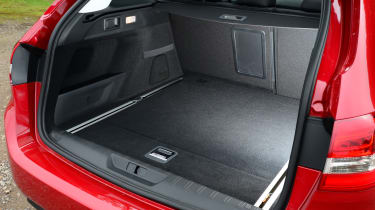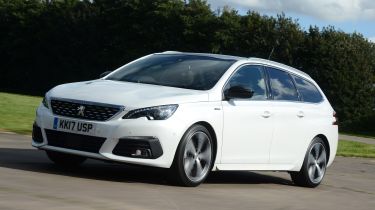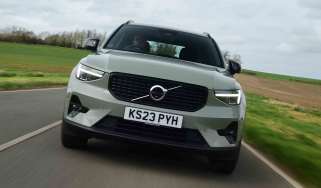Peugeot 308 SW (2013-2021) review
When it comes to compact estates, the 308 SW is the space leader, with a classy cabin and efficient engines

The Peugeot 308 SW is a compact estate that's based on the 308 hatchback. It followed soon after the five-door in 2013, and it shares that car's efficient engine range, elegant looks and generous equipment levels. As well as having a longer rear end, the 308 SW has a slightly longer wheelbase than the hatch, too, and helps to make it one of the most spacious estates in the class.
The SW badge is short for Station Wagon, and has been used on estate versions of Peugeot's compact family car since the 307 SW arrived in 2002. While that car had the unique proposition of having a third row of seats, turning the 307 SW into a seven-seater, the current car is strictly a five-seater - if you want a Peugeot with seven seats, you'll have to go for the 5008 instead.
A light facelift arrived in 2017, bringing the 308 SW's looks in-line with the 3008 SUV thanks to a new grille and front lights. Extra safety kit, better infotainment and a new eight-speed automatic gearbox for the top trim level were also added during the update.
The engine range changed with the facelift, but is generally based around a 1.2-litre e-THP three-cylinder turbo petrol and three diesel engines: the 1.5, 1.6 and 2.0-litre BlueHDi four-cylinder units. The 1.2-litre petrol comes in 110 and 130 guises, the former with a five-speed manual (six-speed following the facelift), the latter with a six-speed manual or EAT6 auto.
Used - available now
The 1.6 BlueHDi comes in 100 and 120 forms, both of which come with a six-speed manual, however, the latter also has a EAT6 auto option.
At the top of the range, the 2.0-litre diesel is offered in 150 or 180 forms. The former has a six-speed manual with the EAT6 auto as an option, while the latter is auto-only.
The 2017 facelift saw the 120 1.6-litre diesel replaced by a slightly more powerful 130 1.5-litre engine. At the same time, the six-speed EAT6 automatic gearbox was replaced by an eight-speed auto, which is fitted to the 1.5-litre 130 diesel engine and the range-topping 2.0-litre diesel.
Trim levels for the 308 SW comprise of Active, Allure, GT Line and GT (the Access model was dropped for the facelift). This is the same as the hatch, although unlike the hatch, there's no 308 GTi estate to rival the likes of the SEAT Leon ST Cupra and Ford Focus ST Estate - though when the facelift arrived, so did a 222bhp 1.6-litre turbo, offered in GT guise only.
Like other rivals, not every engine is available in every trim level. As the name suggests, Access models only came with the entry-level petrol and diesel engines, while Active and Allure cars come with all forms of 1.2 petrol and 1.6 diesel. GT Line cars come with the more powerful 1.2 and 1.6-litre engines, as well as the 2.0 BlueHDi 150, while the GT model only comes with the 2.0 BlueHDi 180 auto, and is the sporty flagship of the range.
All models are reasonably well equipped, especially from Active and above. Access cars get air-con, one-touch electric windows, cruise control, DAB radio and Bluetooth. Active adds 16-inch wheels, dual-zone climate control, parking sensors, auto lights and wipers and sat-nav. Allure brings 17-inch alloys, roof rails, fog lamps and LED headlights, while the GT Line takes the wheels up to 18 inches and adds tinted glass, LED sequential indicators and LED fog lamps, a reversing camera and sporty details inside and out.
The range-topping GT gets similarly sporty add-ons as the GT Line, and also adds a slightly lower ride height, red stitching on the steering wheel and a driver assistance pack with dynamic cruise control and emergency brake assist.
On top of its extensive kit list, the 308 SW is priced competitively, making it a good choice in the compact family estate class. Its main rival for maximum space is the Skoda Octavia Estate, while the SEAT Leon ST, Renault Megane Sport Tourer and Vauxhall Astra Sports Tourer are all worth considering. Then there's the Kia Cee'd Sportswagon, Hyundai i30 Tourer, Toyota Auris Touring Sports, VW Golf Estate and Ford Focus Estate.
There’s no doubt that the Peugeot 308 SW is a better proposition than the first generation car it replaced. It replaced its predecessor’s slack-jawed look with crisp, elegant styling, and it has a great deal of load space for an attractive price.
There’s a strong engine line-up, especially if you’re looking for an economical diesel, although the over-soft ride and lacklustre handling don’t meet the standards of the best in class. Equipment levels are high, but the touchscreen system could do with a little more development.
With build quality much improved, and reliability getting the thumbs up from owners in our Driver Power survey, the 308 SW should appeal to drivers looking for practical family transport. We’d pick the diesel-powered 1.6 BlueHDi 120 in Allure trim for its great mix of performance, kit and economy.
Engines, performance and drive
The pick of the petrol engines is the new 1.2-litre e-THP 130 – it’s a three-cylinder turbo that produces an impressive 128bhp and it’s a real advert for the advantages of downsizing technology.
Fire it up, and it’s reasonably hushed at idle, although the stop-start system does cut in and out with quite a bit of a vibration. It’s paired with a six-speed manual gearbox, but this suffers from a vague, spongy shift that makes changing gears feel like a bit of a chore.
The 308 is at its best with a diesel engine under the bonnet though, as the soft suspension setup and comfort oriented ride mean the hushed and punchy 1.6-litre BlueHDi unit suits the character of the car extremely well.
The top-spec GT model is only available with a 2.0-litre BlueHDi diesel with 178bhp or a 222bhp 1.6-litre petrol, both of which are mated to an eight-speed auto gearbox.
In corners, the soft suspension means there’s plenty of roll, while mid-corner bumps cause it to pitch uncomfortably. What’s more, the small steering wheel feels toy-like in your hands, and an awkward driving position discourages you from attacking bends.
The soft suspension should mean the 308 is comfortable when cruising, but in reality it’s quite unsettled over bumps. The low-speed ride is comfortable and controlled, but cars fitted with the larger alloy wheels are noticeably firmer around town.
Engines
The 308 SW’s three-cylinder turbocharged PureTech petrol engine comes in two guises offering 109bhp and 128bhp respectively – the latter available with manual or auto transmission. 0-62mph takes 11.6 seconds for the smaller engine, and 10 seconds for the more powerful version – and specifying the Quickshift auto shaves another half a second off that time.
The full BlueHDi diesel line-up includes the 99bhp 1.6 with five-speed manual gears only, the 118bhp 1.6 with six-speed manual and auto options (subsequently replaced with a 128bhp 1.5-litre diesel), and two versions of a 2.0-litre unit. First up is the 148bhp version which comes with the choice of manual or auto gears, while the range-topping 178bhp engine is only available as an auto. 0-62mph times range from 12.8 seconds to 8.6 seconds, depending on your choice.
MPG, CO2 and Running Costs
The Peugeot 308 SW is lighter than most of its mainstream rivals thanks to a drastic weight saving scheme during its design, and the estate is 140kg lighter than the car it replaces.
That added lightness combined with a body that has been shaped to be more aerodynamic than before helps produce impressive official fuel economy figures.
Top of the efficiency tree is the 128bhp 1.5-litre Blue 130, which manages 80.7mpg and emits just 93g/km of CO2. The 1.6 BlueHDi 100 is almost as impressive, being officially pegged at 78.5mpg and 95g/km.
The entry-level petrol model is also quite frugal though, and because of this the brand expects it to lead the charge when it comes to private retail buyers. The 1.2-litre triple returns a claimed 57.6mpg.
The 308 SW is on a par with cars like the SEAT Leon ST but comes better equipped as standard, and it undercuts rivals like the Volkswagen Golf and Honda Civic with prices starting at just over £18,500 for the most basic versions, although the residuals are likely to be weaker than either of these competitors.
Standard equipment is impressive though, with even mid-spec cars getting sat-nav and the 9.7-inch touchscreen fitted as standard, ‘Allure’ models get a colour reversing camera, and goodies like 17-inch alloy wheels and full LED lights.
Insurance groups
Insurance cover should be reasonable for most versions of the 308 SW as its group ratings start at 14 for the PureTech petrol Access trim level. The 2.0 GT is predictably more expensive to cover in group 29.
Depreciation
In spite of some notable sporty models in its fairly recent history, Peugeot as a brand has generally failed to set pulses racing. This is reflected in its relatively poor performance on the used market, with our experts predicting it will retain between 31 and 38 per cent of its value after three years and 36,000 miles.
Interior, design and technology
The SW benefits from the same elegant styling as its 308 hatchback brother. Gone are the gaping grille and awkward lines of the 307 SW, replaced by a smart nose, sharp lines and an elegant rear. As well as the extra bodywork behind the rear wheelarches on this estate, a wheelbase that’s 110mm longer creates more room inside.
That also helps with its proportions. The SW is 332mm longer than the hatch, and the addition of the extra back windows, roof rails and large wraparound tail-lights means the estate arguably looks even more stylish. Full LED headlights are standard on Allure models and above, while the top-spec GT model adds lowered suspension and a racy bodykit to mark it out from the rest of the range. The 2017 facelift brought subtle but welcome styling enhancements, including a new radiator grille, with the 308 SW's nose now resembling the flash 3008 SUV as a result.
Inside, the Peugeot has an attractive dash design. The high-set dials are only just visible over the small steering wheel, while the large touchscreen groups the multimedia and climate controls together to leave the centre console uncluttered. An electric parking brake is fitted as standard on higher-spec models, freeing space for storage.
Some models are available with the £500 optional panoramic glass roof, which does a great job of brightening up the cabin, while the electric sunshade also diffuses the light to keep things feeling airy when it’s not in use. As well as looking good, the 308’s interior feels well built, with high-quality plastics present throughout and some subtle metal trim adding a classy touch.
Sat-nav, stereo and infotainment
A 9.7-inch touchscreen is standard across the 308 SW range; it’s an integral part of the Peugeot’s i-Cockpit set-up. Not only does the system control the audio, sat-nav and Bluetooth functions, it also houses the air-con controls.
However, while this helps create a minimalist look for the dashboard, it also means you have to enter various sub-menus just to change the cabin temperature, for example. This process is made more frustrating by the fact that the screen doesn’t always respond promptly to your instructions. While it was improved with the 2017 facelift, the system is still some way off best-in-class.
Peugeot Connect Apps give you access to features such as Michelin travel guides and parking info, but there’s no option to mirror your smartphone’s display on the screen. On the plus side, programming a destination into the sat-nav is a doddle thanks to postcode recognition, plus you’ll receive five years of European mapping updates.
Practicality, comfort and boot space
The 308 SW has one of the biggest boots in its class, but there’s not been quite enough thought given to life inside the car. The glovebox is tiny, and Peugeot hasn’t been lavish with other storage compartments or cubbies.
Also the driving position takes a little getting used to, as you need to drop the small steering wheel down towards your knees to see the dials. At least visibility out of the car is good.
It’s also irritating that you can only adjust the climate control with the touchscreen. So rather than turn a dial, you need to navigate sub- menus and wait for the system to scroll through, which can be a distraction, especially as the display screen isn’t as responsive as rivals’.
Size
The 308 SW’s 4,585mm length means it’s marginally bigger than the 4,562mm VW Golf Estate but a few mm shorter than the Honda Civic Tourer.
Leg room, head room & passenger space
Passenger space in the 308 SW is similar to that found in the rival SEAT Leon ST estate. That means there’s just about enough space for grown-ups, although back-seat passengers sit quite high on the flat bench so it feels like there’s less headroom. The headroom problem is worsened by the optional glass roof, so make sure you try sitting in the back before you buy.
Boot
The 308 SW’s tailgate is heavy to open, but it reveals a 660-litre boot that’s the biggest in the class. Useful touches include load rails in the floor and seat-folding levers in the boot sides, but the load cover is fiddly to hook into place, and you remove it by twisting it out of position, a process that doesn’t feel well engineered.

Once removed, there’s a slot under the boot floor to store it in, and you can hold the floor up using the built-in hook that attaches to the top lip of the tailgate. Again, though, this solution seems a little cheap when compared to some rival systems.
Fold the seats, and the bases drop at the same time to create a completely flat floor. Total capacity of 1,775 litres is excellent for this type of car - even more than the cavernous Honda Civic Tourer.
However, although the 308 SW has lots of room, it has few practical touches. There’s no under-floor storage, and if you want to use the load rails, you have to add a £150 cargo net. What’s more, the 12V socket is mounted above the load cover, which looks unsightly if you’ve something plugged in and the cover closed.
If you want to pull a caravan or trailer, the 308 SW’s towing capacities range from 1,100kgs to 1,500kgs depending on engine size.
Reliability and Safety
The 308 uses a new platform that will underpin a variety of Peugeot and Citroen models, and so far, things are looking good for the architecture. Owners placed the new 308 hatch on which the SW is based 19th out of 75 cars in the 2017 Driver Power survey. The 308 came in for praise where its engine, looks, handing and running costs were concerned, with reliability, practicality and safety features all generated above-average results.
The cabin mainly uses soft-touch plastics but some areas are hard and scratchy which spoils the overall effect. Similarly, the touchscreen can be quite fiddly and the sat-nav is not the most intuitive or accurate system we have tried. The connected apps take quite a long time to load and this system could soon feel a bit outdated when compared to (admittedly more expensive) systems in rival cars. Even so, the major mechanical parts are all tried and tested in other Peugeot products and while the 308 does not come with anything more than a three-year warranty it should be relatively trouble free.
The five-door 308 earned five stars in its Euro NCAP crash test in 2013, although its percentage scores are lower than the SEAT Leon’s. The 308 hatch scored 92 per cent for adult occupant safety, 79 per cent for child occupant safety, and 64 per cent for pedestrian safety. The Leon hatchback’s scores were 94 per cent, 92 per cent and 70 per cent respectively, and although the cars crash-tested were hatchbacks, the results ought to be a fair indication of the estate variants’ likely performance.
Six airbags are standard on the Peugeot, while the 2017 facelift saw the autonomous emergency braking (AEB) improved, with the system now including pedestrian detection - though AEB is not a standard feature across the 308 SW range.
Warranty
The Peugeot comes with the brand’s standard three year/60,000-mile warranty which looks pretty lame compared to the warranty commitment from Kia of seven-years/100,000 miles. To be fair though, the Peugeot warranty offer will serve the purposes of most owners.
Servicing
You can set-up an all-inclusive service plan on the 308 SW from just £19.99 per month, and other options include fixed price maintenance for items like brake pads and tyres. However you approach it, the 308 should be pretty cheap to run.
More reviews
In-depth reviews
Long-term tests
Which Is Best
Most Economical
- Name1.6 Plug-in Hybrid 195 Allure 5dr e-DSC7
- Gearbox typeSemi-auto
- RRP£39,300







